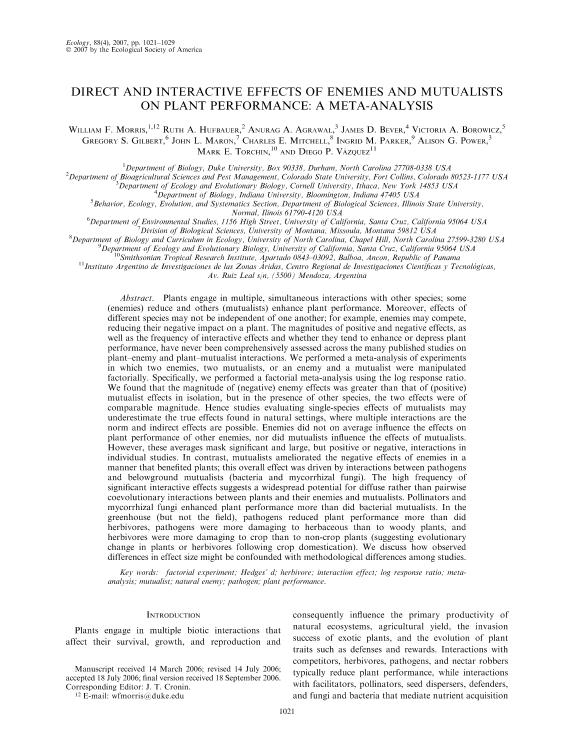Mostrar el registro sencillo del ítem
dc.contributor.author
Morris, William F.
dc.contributor.author
Hufbauer, Ruth A.
dc.contributor.author
Agrawal, Anurag A.
dc.contributor.author
Bever, James D.
dc.contributor.author
Borowicz, Victoria A.
dc.contributor.author
Gilbert, Gregory S.
dc.contributor.author
Maron, John L.
dc.contributor.author
Mitchell, Charles E.
dc.contributor.author
Parker, Ingrid M.
dc.contributor.author
Power, Alison G.
dc.contributor.author
Torchin, Mark E.
dc.contributor.author
Vazquez, Diego P.

dc.date.available
2020-03-16T21:50:35Z
dc.date.issued
2007-04
dc.identifier.citation
Morris, William F.; Hufbauer, Ruth A.; Agrawal, Anurag A.; Bever, James D.; Borowicz, Victoria A.; et al.; Direct and interactive effects of enemies and mutualists on plant performance: A meta-analysis; Ecological Society of America; Ecology; 88; 4; 4-2007; 1021-1029
dc.identifier.issn
0012-9658
dc.identifier.uri
http://hdl.handle.net/11336/99736
dc.description.abstract
Plants engage in multiple, simultaneous interactions with other species; some (enemies) reduce and others (mutualists) enhance plant performance. Moreover, effects of different species may not be independent of one another; for example, enemies may compete, reducing their negative impact on a plant. The magnitudes of positive and negative effects, as well as the frequency of interactive effects and whether they tend to enhance or depress plant performance, have never been comprehensively assessed across the many published studies on plant-enemy and plant-mutualist interactions. We performed a meta-analysis of experiments in which two enemies, two mutualists, or an enemy and a mutualist were manipulated factorially. Specifically, we performed a factorial meta-analysis using the log response ratio. We found that the magnitude of (negative) enemy effects was greater than that of (positive) mutualist effects in isolation, but in the presence of other species, the two effects were of comparable magnitude. Hence studies evaluating single-species effects of mutualists may underestimate the true effects found in natural settings, where multiple interactions are the norm and indirect effects are possible. Enemies did not on average influence the effects on plant performance of other enemies, nor did mutualists influence the effects of mutualists. However, these averages mask significant and large, but positive or negative, interactions in individual studies. In contrast, mutualists ameliorated the negative effects of enemies in a manner that benefited plants; this overall effect was driven by interactions between pathogens and belowground mutualists (bacteria and mycorrhizal fungi). The high frequency of significant interactive effects suggests a widespread potential for diffuse rather than pairwise coevolutionary interactions between plants and their enemies and mutualists. Pollinators and mycorrhizal fungi enhanced plant performance more than did bacterial mutualists. In the greenhouse (but not the field), pathogens reduced plant performance more than did herbivores, pathogens were more damaging to herbaceous than to woody plants, and herbivores were more damaging to crop than to non-crop plants (suggesting evolutionary change in plants or herbivores following crop domestication). We discuss how observed differences in effect size might be confounded with methodological differences among studies.
dc.format
application/pdf
dc.language.iso
eng
dc.publisher
Ecological Society of America

dc.rights
info:eu-repo/semantics/openAccess
dc.rights.uri
https://creativecommons.org/licenses/by-nc-sa/2.5/ar/
dc.subject
FACTORIAL EXPERIMENT
dc.subject
HEDGES' D
dc.subject
HERBIVORE
dc.subject
INTERACTION EFFECT
dc.subject
LOG RESPONSE RATIO
dc.subject
METAANALYSIS
dc.subject
MUTUALIST
dc.subject
NATURAL ENEMY
dc.subject
PATHOGEN
dc.subject
PLANT PERFORMANCE
dc.subject.classification
Ecología

dc.subject.classification
Ciencias Biológicas

dc.subject.classification
CIENCIAS NATURALES Y EXACTAS

dc.title
Direct and interactive effects of enemies and mutualists on plant performance: A meta-analysis
dc.type
info:eu-repo/semantics/article
dc.type
info:ar-repo/semantics/artículo
dc.type
info:eu-repo/semantics/publishedVersion
dc.date.updated
2019-12-05T13:36:13Z
dc.journal.volume
88
dc.journal.number
4
dc.journal.pagination
1021-1029
dc.journal.pais
Estados Unidos

dc.description.fil
Fil: Morris, William F.. University of Duke; Estados Unidos
dc.description.fil
Fil: Hufbauer, Ruth A.. State University of Colorado - Fort Collins; Estados Unidos
dc.description.fil
Fil: Agrawal, Anurag A.. Cornell University; Estados Unidos
dc.description.fil
Fil: Bever, James D.. Indiana University; Estados Unidos
dc.description.fil
Fil: Borowicz, Victoria A.. University of Illinois at Urbana; Estados Unidos
dc.description.fil
Fil: Gilbert, Gregory S.. University of California; Estados Unidos
dc.description.fil
Fil: Maron, John L.. University of Montana; Estados Unidos
dc.description.fil
Fil: Mitchell, Charles E.. University of North Carolina; Estados Unidos
dc.description.fil
Fil: Parker, Ingrid M.. University of California; Estados Unidos
dc.description.fil
Fil: Power, Alison G.. Cornell University; Estados Unidos
dc.description.fil
Fil: Torchin, Mark E.. Smithsonian Tropical Research Institute; Panamá
dc.description.fil
Fil: Vazquez, Diego P.. Consejo Nacional de Investigaciones Científicas y Técnicas. Centro Científico Tecnológico Conicet - Mendoza. Instituto Argentino de Investigaciones de las Zonas Áridas. Provincia de Mendoza. Instituto Argentino de Investigaciones de las Zonas Áridas. Universidad Nacional de Cuyo. Instituto Argentino de Investigaciones de las Zonas Áridas; Argentina
dc.journal.title
Ecology
dc.relation.alternativeid
info:eu-repo/semantics/altIdentifier/doi/http://dx.doi.org/10.1890/06-0442
dc.relation.alternativeid
info:eu-repo/semantics/altIdentifier/url/https://esajournals.onlinelibrary.wiley.com/doi/full/10.1890/06-0442
Archivos asociados
